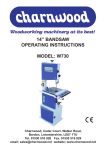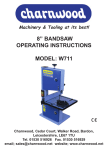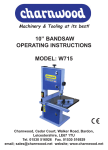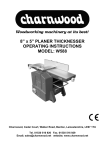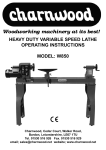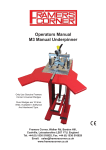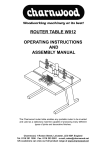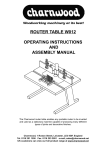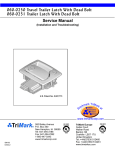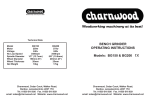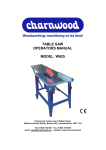Download 12” BANDSAW OPERATING INSTRUCTIONS
Transcript
12” BANDSAW OPERATING INSTRUCTIONS MODEL: W721 Charnwood, Cedar Court, Walker Road, Bardon, Leicestershire, LE67 1TU Tel. 01530 516 926 Fax. 01530 516 929 email; [email protected] website; www.charnwood.net GENERAL SAFETY RULES WARNING: Do not attempt to operate the machine until you have thoroughly read and understood completely all instructions, rules, etc. contained in this manual. Failure to comply may result in accidents involving fire, electric shock, or serious personal injury. Keep this owner's manual and review frequently for continuous safe operation. 1. Know your machine. For your own safety, read the owner's manual carefully. Learn its application and limitations, as well as specific potential hazards pertinent to this machine. 2. Make sure all tools are properly earthed. 3. Keep guards in place and in working order. If a guard must be removed for maintenance or cleaning, make sure it is properly replaced before using the machine again. 4. Remove adjusting keys and spanners. Form a habit of checking to see that the keys and adjusting spanners are removed from the machine before switched it on. 5. Keep your work area clean. Cluttered areas and workbenches increase the chance of an accident.' 6. Do not use in dangerous environments. Do not use power tools in damp or wet locations, or expose them to rain. Keep work areas well illuminated. 7. Keep children away. All visitors should be kept a safe distance 8. from the work area. 9. Make workshop childproof. Use padlocks, master switches and remove starter keys. 10. Do not force the machine. It will do the job better and be safer at the rate for which it is designed. 11. Use the right tools. Do not force the machine or attachments to do a job for which they are not designed. Contact the manufacturer or distributor if there is any question about the machine's suitability for a particular task. 12. Wear proper apparel. Avoid loose clothing, gloves, ties, rings, bracelets, and jewellery which could get caught in moving parts. Non-slip footwear is recommended. Wear protective hair covering to contain long hair. 13. Always use safety glasses. Normal spectacles only have impact resistant lenses. They are not safety glasses. 14. Do not over-reach. Keep proper footing and balance at all times. 15. Maintain the machine in good condition. Keep the machine clean for best and safest performance. Follow instructions for lubrication and changing accessories. 16. Disconnect the machine from power source before servicing and when changing the blade. 17. Never leave the machine running unattended. Turn the power off. Do not leave the machine until it comes to a complete stop. 18. Do not use any power tools while under the effects of drugs, alcohol or medication. 19. Always wear a face or dust mask if operation creates a lot of dust and/or chips. Always operate the tool in a well ventilated area and provide for proper dust removal. Use a suitable dust extractor. ADDITIONAL RULES FOR BAND SAWS 1. Ensure that the saw table is clear of off-cuts, tools or anything else that might foul the work-piece. 2. When cutting long boards use one or more roller stand(s) to support the work or have a competent helper to support it as it feeds off the rear of the table. 3. Always make sure that the blade is tracked and tensioned correctly before starting to use the saw. 4. Always use a brush to clear the table of dust or debris. NEVER use your hands, especially when the machine is running. 5. Always ensure that the thrust bearings and guide blocks are correctly adjusted before using the saw. 6. ALWAYS USE A PUSH STICK WHEN IT IS NECESSARY TO PUSH ANY PIECE OF MATERIAL OF SUCH SIZE THAT IT WOULD BRING YOUR HANDS WITHIN 30 CM OF THE BLADE. 7. Do not cut material that is badly warped or which has screws or nails in it. 8. Be extra vigilant when cutting stock which has loose knots in it as these my fly out of the saw. 9. NEVER tilt the table when the saw is running. 10. To avoid exposure to hazardous dust, do not use this saw without connecting it to a suitable dust extractor. 11. Always work with a sharp saw blade and feed the work at a rate suited to the thickness and hardness of the material. Note: This band saw has been designed and built solely as a woodworking machine. Do not modify it in any way or use it for anything other than its designated purpose. Neither the manufactures nor the supplier are liable for any damage or injury caused by incorrect assembly, operation or electrical connection of this machine. Specification Table size 550 x 400 mm Table height 1090 mm Motor 750W Blade length 2240 mm Blade widths 6 to 19 mm Blade speeds (no load) 360 and 720 m/min Blade widths 6 to 12 mm Maximum depth of cut at 90o 160 mm Maximum depth of stock at 45o 89.4 mm Throat capacity 305 mm Dust extractor hose connection 100 mm Weight 73kg nett Dimensions (W x D x H) 800 x 630 x 1720 mm Features Precision ground, cast iron table with adjustable scale on rip fence carrier 0 to 45o table tilt High Quality, British made blade High blade speed for cutting most wood Low blade speed for cutting very hard woods, plastic and metal (with a suitable blade) Easily portable machine Quick release, positive lock rip fence Cross cut/mitre fence with easily read scale Tool free blade tracking and tensioning Unpacking Cut the strapping, open the carton and remove all parts from the packaging Assembly Building the stand This is most easily accomplished on a bench or table Leave all nuts and bolts finger tight until you have finished assembling this stand. Start with the long top rail and bolt it inside one leg. Add a short rail, making sure that it sits above the long rail as viewed from the underside, i.e. as you have it on the bench. Continue until all four legs and rails are joined. Add the lower rails and feet. Carefully align the parts until the stand is square and ensure that the 4 large holes in the top corners are lined up as you will need to put bolts through these to fix the saw to the base. Fitting the Saw to the Stand If you have someone to help you, the easiest way to join the saw and the stand is to lift the saw and lower it into place. Secure it with the four countersunk setscrews, washers and nuts provided. Fixing bolts Alternately; If you have nobody to help, lower the saw onto its back and bolt the stand to it. After tightening the fixing bolts, lift the top of the saw and pivot it on the rear feet until it is upright and all four feet are on the ground. Screw the longest of the 6 mm hex headed bolts into its hole as shown. Place the table in position on the trunnion and fix it with the four remaining 6 mm bolts. Check to see if the blade is centred in the slot. You will probably find that it is offset to one side or the other. This pointer is adjustable if the setscrew is loosened. You may need to make a small adjustment after the table is set perpendicular to the blade. If the table needs to be moved laterally to centre the slot on the blade, loosen these three screws, move the table to the correct position and retighten the bolts. Screw the four hex, wing bolts and washers into the tapped holes on the underside of the table and slide the rip fence carrier on to them. Adjust the two hex headed bolts so that the carrier fits snugly to the table with no gap between its upper edge and the table. If you do not keep the carrier tight to the table the rip fence will not be perpendicular to it. Screw in and lock the push stick hanger. Hang the push stick on it and remember that this is one of the world’s best finger preservers! Locate the tension adjustment knob and using a suitable tool, remove the cap. Be careful not to lose the nut which is inside. Place it over the spindle sticking out of the top of the saw, screw on the nut and lock the knob between the two nuts. Replace the cap. Fit the control handle to the spindle protruding from the side of the saw. Rotate the handle, so that the grubscrew tightens onto the flat side on the spindle. Tighten the grubscrew securely. Apply a little tension to the blade and use a set square to position the table at right angles to it. Lock it in position and if necessary, adjust the level stop screw and the pointer so that it aligns with the zero as shown earlier. Setting up your saw Quick blade tensioner (shown in tight position). Looking from the front of saw, turn the lever anticlockwise to slacken the tension. Blade guard positioner and lock Tracking control and lock After ensuring that the quick tension lever is set in the tensioned position, adjust the blade tension with the hand wheel on top of the upper housing. ‘Pluck’ the back of the blade, as you would the string of a double bass, at this point. As the blade tension is increased, the pitch of the sound will rise. Stop increasing the tension as soon as the sound starts to become dull. Alternatively, raise the blade guard to its highest position and adjust tension until the blade, at the midpoint between table and guard can be deflected only 3 to 5 mm with finger pressure. Turn the upper wheel clockwise, by hand and adjust the tracking control until the blade is centred on the wheel, as shown in the inset illustration. Lock the adjuster in this position. The upper and lower thrust and guide bearings should be set up next. Thrust bearing Guide bearing Guide bearing locking screws Thrust bearing locking screw The thrust bearing should be about 0.5 mm behind the back of the blade. Adjust it and lock it place. Slacken the guide bearing locking screws, move the bearings in until they touch the blade. Rotate the top wheel by hand a few turns and lock the be\rings in place. The lower thrust bearing and guide pins are adjusted similarly. Guide pin locking screw (on rear face) Guide pin Lower thrust bearing Blade guard Release the belt tension by turning the tension control handle on the front of the lower housing. Move the belt from the larger pulley to the smaller one and then from the smaller to the larger on the other pair. Always have the drive belt on one large and one small pulley. This bandsaw is equipped with a cross cut/mitre fence which can be fitted as shown. The fence is equipped with adjustable stops for 45° and 90° cuts. The rip fence is reversible and may be used on either side of the blade. Your bandsaw is now ready for use but it is recommended that a suitable dust extractor is connected before use. Changing the Blade Bandsaw blades are sharp enough to cause injury even when too blunt to cut wood! It is recommended that protective gloves be worn when handling blades. Unplug the bandsaw from the mains socket, slacken off the blade tension and open the upper and lower housing doors. Although there are two micro-switches which will prevent the saw from being started with a door open, disconnection is a good habit to develop. Lower the blade guard Remove the rip fence carrier Slide the blade off upper and lower wheels, bringing it out of the machine via the slots in the rear frame and the blade guard. Reverse these steps to fit the new blade. Ensure that the teeth are at the front and pointing down. Position the blade between the guide bearings and pins. Tension and adjust the tracking as done during the initial set up. Check and adjust, if necessary, the position of the bearings and the guide pins. W721 Parts List No 001 003 005 007 009 011 013 015 017 019 021 023 025 027 029 031 033 035 037 039 041 043 045 047 049 051 053 055 057 059 061 063 065 067 069 071 073 075 077 079 081 083 085 087 089 091 093 095 Name Lower door Spacer bush n/a Spring plate Pilot pin Circlip Upper bearing bolt support Hex. flanged nut Shaft Spring Slider Cover board Guide carrier extrusion n/a Pinion shaft Self tapping screw Knurled screw Cap head screw Knurled nut Pilot shaft Bearing Brush Flanged nut Idler wheel Sliding shaft Cam End cap Thin hex nut Blade tensioner bracket Quick release shaft bearing Thin nut Thin nut Setting knob Hex head bolt Wing nut Washer Locking knob Adjusting knob Lower bearing bolt Knurled thumbscrew Motor pulley Nut Shaft Locking handle Upper trunion Pointer Screw Table Qty 1 2 2 2 2 1 4 1 1 1 1 1 1 2 4 1 2 2 4 1 1 1 1 1 1 1 1 1 1 1 1 8 5 4 1 1 1 1 1 1 1 1 1 1 1 1 No 002 004 006 008 010 012 014 016 018 020 022 024 026 028 030 032 034 036 038 040 042 044 046 048 050 052 054 056 058 060 062 064 066 068 070 072 074 076 078 080 082 084 086 088 090 092 094 096 Name Cap head bolt Lock nut Pilot guide Rivet Upper door Upper bearing bolt Nut Guide plate Split washer Tension bracket frame Self tapping screw Rack Plastic guide Pinion Bottom cap Cap head screw Bearing housing Guide bearing Thrust bearing Upper wheel Coach bolt spacer Circlip Bearing NVR switch Tapped flange Setting knob Threaded rod Nut Quick release shaft Locking handle Cap Hex head bolt Washer Hex head bolt Turn lock fastener Washer n/a Dust extraction outlet Guide pin housing Motor Hand wheel Gearwheel Spacer Lower trunnion Spacer Coach bolt Table insert Qty 4 4 3 4 1 1 1 2 2 1 2 1 2 1 1 2 1 1 1 1 1 1 1 2 1 1 1 1 1 1 1 1 1 13 4 2 1 1 1 1 1 2 1 1 2 2 1 097 099 101 103 105 107 109 111 113 115 117 119 121 123 125 127 129 131 133 135 137 139 141 143 145 Wing nut Fence bracket Fence Fence carrier Self tapping screw Handle Shaft Cap head bolt Rip fence carrier Cover plate, left Hand wheel Belt tensioner shaft Microswitch cover Microswitch box Lock washer Blade guard Belt Cap head bolt Spacer Spring washer Spring washer Frame Parallel pin Spring Push stick 2 1 1 1 2 1 1 2 1 1 1 1 2 2 4 1 1 3 1 3 1 1 1 1 1 098 100 102 104 106 108 110 112 114 116 118 120 122 124 126 128 130 132 134 136 138 140 143 144 145 End cap Coach bolt Pressure plate Plastic pressure plate Cam Cap Pointer Cover plate, right Wing bolt Handle Setting collar Screw Microswitch Nut Self tapping screw Tyre Blade Lower wheel Pulley Hex nut Fixing plate Scale Table angle scale Spacer Hook 2 2 1 1 1 1 1 1 4 1 1 4 2 4 4 2 1 1 1 1 1 1 1 1 1
















